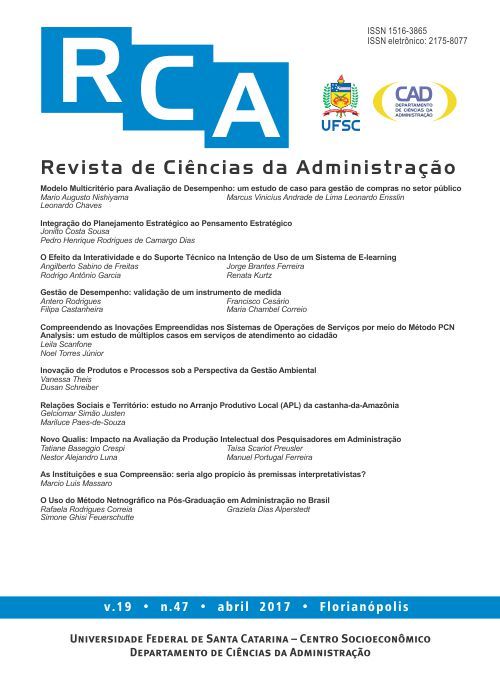Modelo Multicritério para Avaliação de Desempenho: um estudo de caso para gestão de compras no setor público
DOI:
https://doi.org/10.5007/2175-8077.2017v19n47p9Resumo
O presente trabalho tem como objetivo construir um modelo para apoiar a gestão do processo de compras e de suprimentos de uma organização pública de ensino. O instrumento de intervenção utilizado foi a metodologia Multicritério de Apoio à Decisão Construtivista (MCDA-C), que é dividida em três etapas: (i) Estruturação; (ii) Avaliação; e (iii) Recomendações. A aplicação desta metodologia permitiu identificar os principais aspectos que afetam a gestão do processo de compras e suprimentos, segundo a percepção do gestor. Trata-se de uma pesquisa de caráter exploratório, baseada em um estudo de caso realizado em uma organização pública brasileira. Foram identificados, organizados, mensurados e integrados os fatores necessários e suficientes para a gestão do processo de compras e suprimentos. A construção do modelo permitiu desenvolvimento de um instrumento de gestão que incorpora elementos gráficos e numéricos que ressaltam os pontos fracos e os mais competitivos do processo estudado.Downloads
Publicado
Como Citar
Edição
Seção
Licença
O autor deve garantir:
- que haja um consenso completo de todos os coautores em aprovar a versão final do documento e sua submissão para publicação.
- que seu trabalho é original, e se o trabalho e/ou palavras de outras pessoas foram utilizados, estas foram devidamente reconhecidas.
Plágio em todas as suas formas constituem um comportamento antiético de publicação e é inaceitável. RCA reserva-se o direito de usar software ou quaisquer outros métodos de detecção de plágio.
Todas as submissões recebidas para avaliação na revista RCA passam por identificação de plágio e autoplágio. Plágios identificados em manuscritos durante o processo de avaliação acarretarão no arquivamento da submissão. No caso de identificação de plágio em um manuscrito publicado na revista, o Editor Chefe conduzirá uma investigação preliminar e, caso necessário, fará a retratação.
Os autores cedem à RCA os direitos exclusivos de primeira publicação, com o trabalho simultaneamente licenciado sob a Licença Creative Commons (CC BY) 4.0 Internacional.

Os autores têm autorização para assumir contratos adicionais separadamente, para distribuição não exclusiva da versão do trabalho publicada neste periódico (ex.: publicar em repositório institucional, em site pessoal, publicar uma tradução, ou como capítulo de livro), com reconhecimento de autoria e publicação inicial neste periódico.
Esta licença permite que qualquer usuário tenha direito de:
Compartilhar – copiar, baixar, imprimir ou redistribuir o material em qualquer suporte ou formato.
Adaptar – remixar, transformar e criar a partir do material para qualquer fim, mesmo que comercial.
De acordo com os seguintes termos:
Atribuição – Você deve dar o crédito apropriado (citar e referenciar), prover um link para a licença e indicar se mudanças foram feitas. Você deve fazê-lo em qualquer circunstância razoável, mas de maneira alguma que sugira ao licenciante apoiar você ou o seu uso.
Sem restrições adicionais – Você não pode aplicar termos jurídicos ou medidas de caráter tecnológico que restrinjam legalmente outros de fazerem algo que a licença permita.


